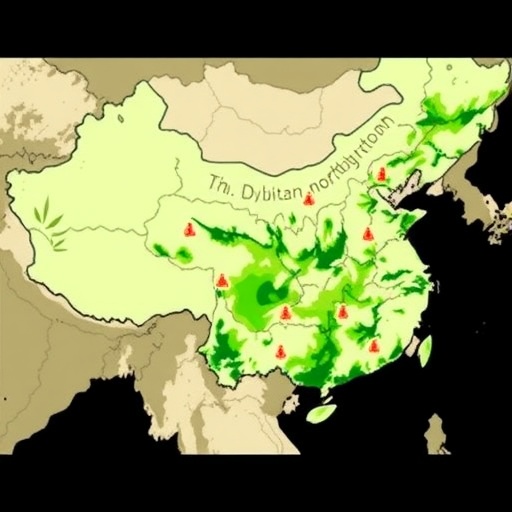In recent years, the urgency to address climate change has brought attention to the significant role that soil organic carbon (SOC) plays in agricultural systems. Soil organic carbon is not only essential for soil health and fertility, but it also acts as a critical component in regulating the carbon cycle, thus influencing atmospheric carbon dioxide levels. A new study authored by Zhang et al., published in Environmental Monitoring and Assessment, offers a breakthrough in predicting the distribution and content of cropland SOC, focusing specifically on the Northeast China Plain—a region grappling with various agricultural challenges.
The Northeast China Plain is known for its vast agricultural landscapes and is home to some of the most productive croplands in the country. However, rapid industrialization and urban expansion have posed challenges to sustainable agricultural practices, leading to concerns about soil degradation and reduced fertility. Understanding the spatial distribution of soil organic carbon in this area is vital for informed land management and agricultural planning. Traditional soil sampling methods, while useful, are often costly and time-consuming, limiting the ability to capture the complexity of SOC dynamics across large regions.
The researchers in this study harness the power of deep learning, a subset of artificial intelligence, to enhance the accuracy and efficiency of SOC predictions. By employing advanced machine learning algorithms, the authors were able to create a predictive model that utilizes a combination of spectral data, environmental factors, and land-use information. This innovative approach has the potential to revolutionize the monitoring of soil health across agricultural landscapes and provide essential insights into carbon sequestration capabilities.
Deep learning techniques rely on neural networks that mimic the human brain’s interconnected structure, allowing for sophisticated pattern recognition. In their research, the authors trained their model using extensive datasets that included soil measurements, satellite imagery, and climatic variables. By doing so, they could refine their predictions and account for the multifaceted interactions affecting soil organic matter. The model was then validated using an independent dataset, yielding impressive results that challenged existing methodologies in soil carbon assessment.
One of the standout features of this study is its ability to identify spatial variability in SOC content across different types of land use. The findings showed that regions dedicated to certain agricultural practices exhibited varying levels of SOC, providing valuable insights into how different farming methods impact soil quality. For instance, the results suggested that crop rotation and organic farming techniques are linked to higher SOC concentrations compared to traditional monoculture practices, emphasizing the importance of adopting sustainable agriculture strategies.
Additionally, the research found that environmental factors such as precipitation, temperature, and soil texture significantly influence SOC distribution. By integrating these variables into the deep learning framework, the model was able to track changes in SOC levels over time and predict how potential adjustments in climate could affect soil health. This aspect of the study highlights the intricate interplay between climate change and agriculture and stresses the need for adaptive agricultural practices that mitigate adverse effects.
Furthermore, the authors reported that their model demonstrated superior performance metrics compared to conventional regression-based approaches. Accuracy measurements revealed that the deep learning model reduced prediction errors significantly, providing a robust tool for researchers and policymakers. Notably, this advancement allows for the scaling up of SOC assessments, making it feasible to monitor vast agricultural landscapes that were previously neglected due to resource constraints.
The implications of this research extend beyond the immediate context of the Northeast China Plain. By establishing a reliable modeling framework, the authors have opened new avenues for understanding soil carbon dynamics globally. Policymakers and agronomists around the world can utilize similar methodologies to assess SOC in various ecological contexts, thereby enhancing food security and promoting sustainable land use practices.
As agricultural lands face increasing pressure from climate change, understanding the role of soil organic carbon becomes more urgent. This study serves as a reminder of the critical relationship between soil management and climate resilience. The ability to accurately model and predict SOC distribution empowers farmers and land managers to implement evidence-based practices that enhance soil health and productivity.
In conclusion, Zhang et al.’s research marks a significant advancement in our understanding of soil organic carbon dynamics within agricultural systems. By employing innovative deep learning techniques, the study not only refines our understanding of SOC distribution in the Northeast China Plain but also offers a blueprint for future research across diverse agricultural regions. As the world confronts the challenge of sustainable food production in the wake of climate change, the findings from this study will prove invaluable in guiding effective land management strategies.
The authors advocate for a shift towards integrating advanced technological solutions in agricultural research and practice. By leveraging artificial intelligence, farmers and policymakers can better navigate the complexities of soil management and climate adaptation. The study represents not just a scientific endeavor, but a meaningful step towards fostering a sustainable future for agriculture worldwide.
This groundbreaking work emphasizes the necessity for continued investment in research that bridges the gap between science and practice. Enhanced understanding of soil integral functions will ensure that as we push forward into an uncertain future, agriculture can remain productive and resilient, safeguarding essential resources for generations to come.
Subject of Research: Regional cropland soil organic carbon content and distribution using deep learning.
Article Title: Prediction of regional cropland soil organic carbon content and distribution using deep learning: a case study of the Northeast China Plain.
Article References:
Zhang, S., Dai, H., Chen, C. et al. Prediction of regional cropland soil organic carbon content and distribution using deep learning: a case study of the Northeast China Plain.
Environ Monit Assess 197, 1159 (2025). https://doi.org/10.1007/s10661-025-14622-1
Image Credits: AI Generated
DOI: N/A
Keywords: Soil Organic Carbon, Deep Learning, Agriculture, Climate Change, Sustainable Practices, Northeast China Plain.




